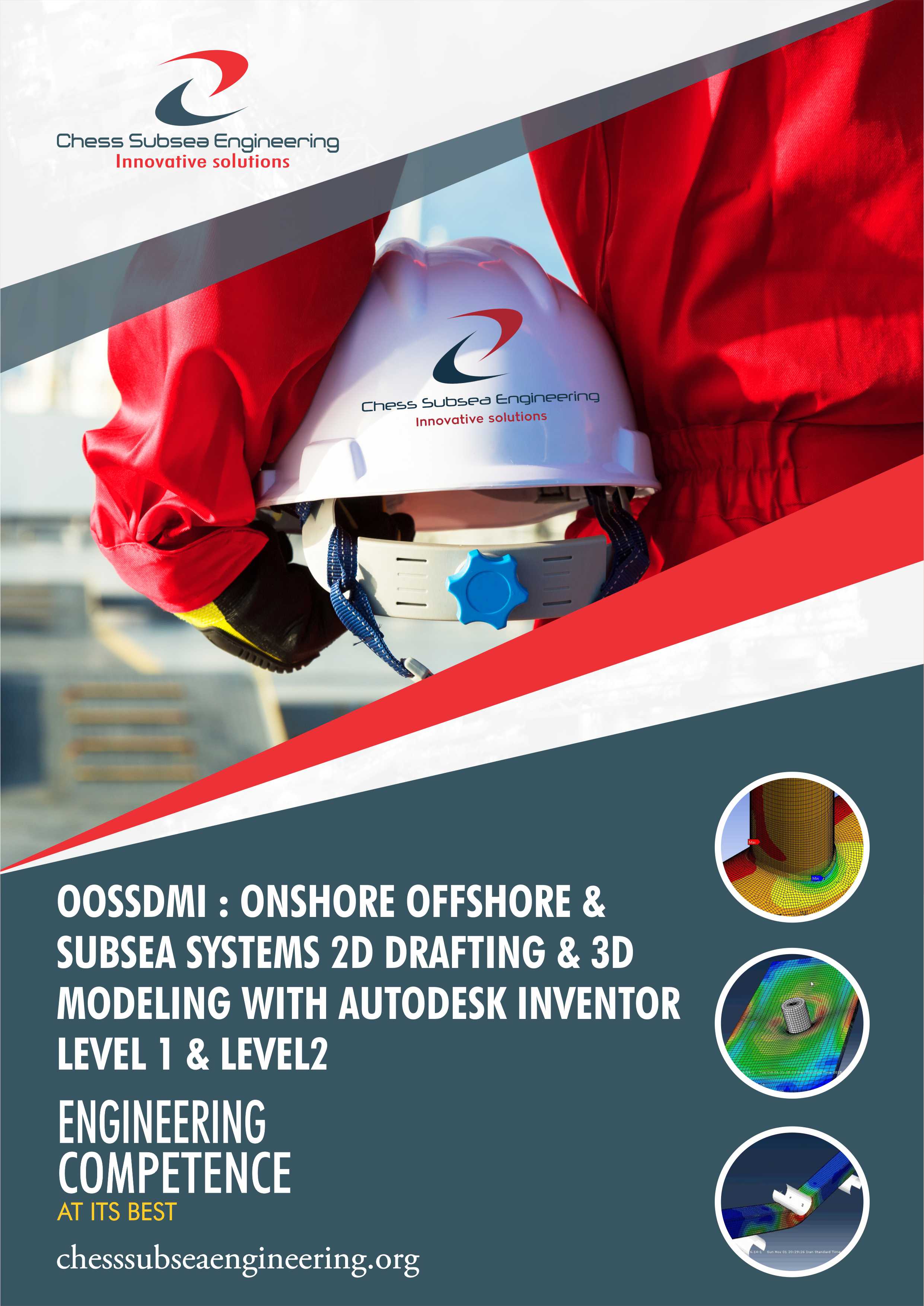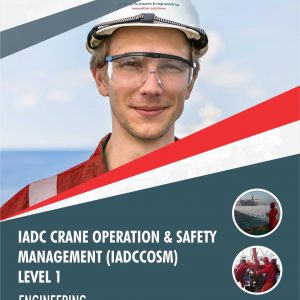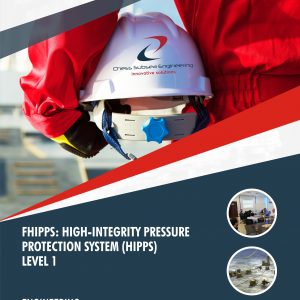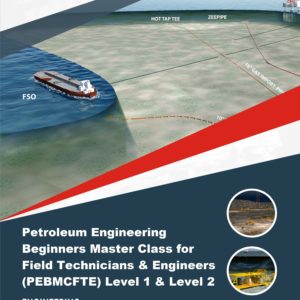Description
The OOSSDMI Level 1 course is designed to provide participants with a comprehensive understanding of 2D drafting and 3D modeling techniques using Autodesk Inventor software, specifically focused on onshore, offshore, and subsea systems. It covers topics such as creating 2D technical drawings, designing 3D models of complex systems, and utilizing advanced features of Autodesk Inventor.
The OOSSDMI Level 2 course builds upon the knowledge gained in Level 1 and focuses on advanced 2D drafting and 3D modeling techniques for onshore, offshore, and subsea systems. It delves deeper into topics such as parametric modeling, assembly design, and simulation analysis, enabling participants to develop advanced skills in designing and analyzing complex systems.
Both the Level 1 and Level 2 courses emphasize practical applications and hands-on learning. Participants will have the opportunity to work on real-world projects and design exercises, allowing them to apply the learned techniques to create accurate and detailed 2D drawings and realistic 3D models of onshore, offshore, and subsea systems.
The courses also cover relevant industry standards and practices for onshore, offshore, and subsea systems design. Participants will become familiar with industry-specific drafting and modeling standards, ensuring compliance and accuracy in their design work.
Upon completion of the OOSSDMI Level 1 and Level 2 courses, participants will possess the necessary knowledge and skills to effectively create 2D drawings and develop 3D models of onshore, offshore, and subsea systems using Autodesk Inventor. They will be capable of designing and visualizing complex systems, making informed design decisions, and collaborating with multidisciplinary teams in the engineering and design fields.
Through this course offering, you will be empowered with tools to create high-end function digital prototypes of subsea systems & components mechanical designs. With a friendly training style and high-profile practical exercises, at the end of the program, you will be equipped to create amazing 3D subsea systems & components mechanical designs using Autodesk inventor.
You will learn how to create advanced and real-time functional drawings and BOM that update on the go as you work on your designs. We provide best-in-class training through this course on drawing automation.
Course Outline
Subsea Production Systems
Subsea Field Architecture
Subsea Distribution Systems
Offshore & Subsea Surveys
Subsea Structures Installation and Vessels
Subsea Cost Estimation
Subsea Control Systems
Subsea Power Supply
Subsea Project Execution and Interfaces
Autodesk Inventor Sketching Environment
Invoking the Sketching Environment
Introduction to the Sketching Environment
Setting Up the Sketching Environment
Sketching Entities
Positioning Entities by Using Dynamic Input
Deleting Sketched Entities
Finishing a Sketch
Understanding the Drawing Display Tools
Adding Geometric Constraints to a Sketch
Viewing the Constraints Applied to a Sketched Entity
Controlling Constraints and Applying them Automatically while Sketching
Constraints Settings Dialog Box
Deleting Geometric Constraints
Adding Dimensions to Sketches
Setting the Scale of a Sketch
Creating Driven Dimensions
Understanding the Concept of Fully-Constrained Sketches
Measuring Sketched Entities
Editing Sketched Entities
Creating Patterns
Writing Text in the Sketching Environment
Writing Text Aligned to a Geometry
Inserting Images and Documents in Sketches
Editing Sketched Entities by Dragging
Converting the Base Sketch into a Base Feature
Extruding the Sketch
Revolving the Sketch
Direct Manipulation of Features by Using the Mini Toolbar
Rotating the View of a Model in 3D Space
Controlling the Display of Models
Creating Freeform Shapes
Need for other Sketching Planes
Work Features
Other Extrusion Options
Other Revolution Options
The Concept of Sketch Sharing
Creating Holes
Creating Fillets
Creating Chamfers
Mirroring Features and Models
Creating Rectangular Patterns
Creating Circular Patterns
Creating Rib Features
Thickening or Offsetting the Faces of Features
Creating the Embossed and Engraved Features
Applying Images on a Feature
Assigning Different Colors/Styles to a Model
Assigning Material to a Model
Concept of Editing Features
Suppressing and Unsuppressing the Features
Editing of a feature using the Direct Tool
Deleting Features
Copying and Pasting Features
Manipulating Features by EOP
Adding Automatic Dimensions to Sketches
Projecting Entities in the Sketching Environment
Creating Sweep Features
Creating Lofted Features
Creating Coil Features
Creating Threads
Creating Shell Features
Applying Drafts
Creating Split Features
Trimming Surfaces
Extending Surfaces
Deleting Faces
Replacing Faces with Surfaces
Creating Planar Boundary Patches
Stitching Surfaces
Working with the Sculpt Tool
Working with the Bend Part Tool
Reordering the Features
Using the Sketch Doctor
Using the Design Doctor
Assembly Modeling
Types of Assemblies
Creating Top-down Assemblies
Creating Bottom-Up Assemblies
Assembling Components by Using the Constrain Tool
Specifying the Limits for Constraining
Assembling Parts by Using the Assemble Tool
Using ALT+Drag to Apply Assembly Constraints
Applying Joints to the Assembly
Showing and Hiding Relationships
Moving Individual Components
Rotating Individual Components in 3D Space
Editing Assembly Constraints
Editing Components
Creating Subassemblies
Checking Degrees of Freedom of a Component
Creating the Pattern of Components in an Assembly
Replacing a Component from the Assembly File with another Component
Mirroring Subassemblies or Components of an Assembly
Copying Subassemblies or Components of an Assembly
Deleting Components
Editing the Pattern of Components
Making a Pattern Instance Independent
Deleting Assembly Constraints
Creating Assembly Section Views in the Assembly File
Analyzing Assemblies for Interference
Creating Design View Representations
Simulating the Motion of Components
Creating Positional Representations
Viewing the Bill of Material of the Current Assembly
Working with Assembly Features
The Drawing Module
Types of Views
Generating Drawing Views
Drafting Drawing Views
Editing Drawing Views
Deleting Drawing Views
Moving Drawing Views
Copying Drawing Views
Rotating Drawing Views
Changing the Orientation of Drawing Views
Assigning Different Hatch Patterns to Components in Assembly Section Views
Editing the Default Hatch Style of the Sectioned Objects
Excluding Components from Assembly Section Views
Modifying Drawing Standards
Inserting Additional Sheets into Drawing
Activating a Drawing Sheet
Displaying Dimensions in Drawing Views
Modifying the Model Dimensions
Editing Drawing Sheets
Creating Dimension Styles
Applying Dimension Styles
Modifying a Dimension and its Appearance Using the Shortcut Menu
Adding the Parts List
Editing the Parts List
Setting the Standard for the Parts List
Adding Balloons to Assembly Drawing Views
Adding Text to a Drawing Sheet
Creating Presentation View
Defining Units for Presentation Files
Tweaking Components in the Presentation View
Animating an Assembly
Rotating the Presentation View Precisely
Assessment
Participant underpinning knowledge of Onshore Offshore & Subsea Systems 2D Drafting & 3D Modeling will be accessed with on the job subsea structures case studies to be presented towards end of course.
Professional Certificate
Issued directly by Chess Subsea Engineering Europe.
How to Register
Click here to download registeration booklet on msword and email completed booklet to info@chesssubseaengineering.org directly.










